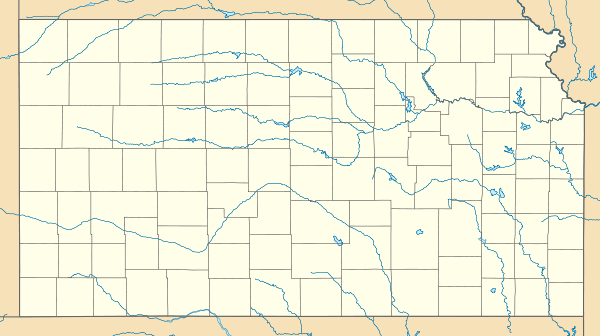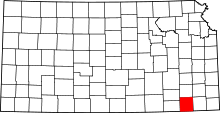Le Hunt, Kansas
| Le Hunt, Kansas | |
|---|---|
| Ghost Town | |
 KDOT map of Montgomery County (legend). Le Hunt is located roughly where the Elk City State Park icon is situated. | |
 Le Hunt  Le Hunt | |
| Coordinates: 37°16′9″N 95°45′7″W / 37.26917°N 95.75194°WCoordinates: 37°16′9″N 95°45′7″W / 37.26917°N 95.75194°W[1] | |
| Country | United States |
| State | Kansas |
| County | Montgomery |
| Elevation[1] | 804 ft (245 m) |
| Population | |
| • Total | 0 |
| Time zone | UTC-6 (CST) |
| • Summer (DST) | UTC-5 (CDT) |
| Area code | 620 |
| FIPS code | 20-39275 [1] |
| GNIS ID | 484489 [1] |
Le Hunt (sometimes rendered as LeHunt) is a ghost town in Montgomery County, Kansas, United States. While most of the site has been reclaimed by nature, the ruins of the United Kansas Portland Cement Company plant can still be seen today in the woods along the eastern shore of Elk City Lake.
History
Le Hunt can trace its origins back to 1905, when the United Kansas Portland Cement Company purchased 1500 acres a few miles northwest of Independence, Kansas and built a large factory. To accommodate the factory's many workers, a company town was established by United Kansas Portland Cement Company.[2][3] The town was named after Leigh Hunt, the president of the Hunt engineering company of Michigan that had worked to construct the plant.[4][3] By 1906, the fledgling town was home to over 1000 individuals,[3] and around this time, Tom Mix (who would go on to be a famous American film actor and the star of many early Western movies) served as the small town's marshal.[5]
Following its establishment, the United Kansas Portland Cement Company suffered several years of financial issues, largely due to the failings of the Kansas cement industry. In 1913, the local newspaper announced that the plant would be temporarily closed to make repairs and sell its surplus stock. By January 1914, the company filed for bankruptcy. In 1915, the plant was purchased by the Sunflower Portland Cement Company.[6] Following the first world war, price fluctuations caused the Sunflower Portland Cement Company to be purchased in 1918 by its rival, the Western States Portland Cement Company, which after a series of mergers and purchases, became a part of the United States Steel Corporation. These events led to the Le Hunt plant closing, its equipment being sold off, many of the homes located in Le Hunt being moved elsewhere. With limited housing and no major company to anchor the settlement, Le Hunt faded until it was nothing more than a derelict ghost town.[7]
Today, ruins of the cement plant still remain in the woods off 5000 Rd. Most prominent is the factory's long-abandoned smoke stack, which rises above the tree line.[8] According to Legends of America, "While trees and weeds try to choke out where the town's cement plant once stood, the walls, ovens and giant smokestack of the factory are still remarkably intact."[9] Ruins of old houses as well as the settlements cemetery are also present, but they have largely been reclaimed by nature.[8]
Haunted reputation
The ruins of the Le Hunt cement factory are rumored to be haunted by the ghost of a man named Boars. The story goes that this man was working on a 15-foot wall, when he was trapped and then covered in cement, wherein he died. His fellow workers decided to honor him by embedding his pickax and wheelbarrow into the side of a wall-cum-memorial (etched with his name) that still stands a short distance away from the smoke stack. Boar's shovel and wheelbarrow can still be seen sticking out from the wall, although the wooden handle of the shovel has been destroyed by the elements. The name "Boars" is also visibilly etched into he concrete edifice. Many claim that because of this incident, Boars' ghost lingers in the area.[3][9][8] However, while the story is popular in the area, author Cheryl Carvajal notes that the abandoned cement plant is "more haunting than haunted."[5]
Others believe that the settlement's cemetery, located only a short distance away from the plant, is haunted. One popular tale, as recounted by Carvajal, contends that around 1906, a young Greek immigrant named Maria befriended Shep, the dog of then-marshal Tom Mix. The two were tragically killed in a wagon incident and, because Maria was of immigrant origin, she was buried unceremoniously outside the southern fence of the cemetery. It is said that the ghost of both Maria and Shep can sometimes be seen strolling in and near their final resting place.[5]
References
- 1 2 3 4 Geographic Names Information System (GNIS) details for Le Hunt, Kansas; United States Geological Survey (USGS); October 13, 1978.
- ↑ Ratzlaff, Robert K. (1996). Shumsky, Neil L., ed. American Cities: A Collection of Essays. 1. Taylor & Francis. p. 273–278.
- 1 2 3 4 Moore, Justing Tyler (May 2010). "United Kansas Portland Cement Company". Abandoned Oklahoma. Retrieved May 4, 2017.
- ↑ Ratzlaff (1996), p. 276.
- 1 2 3 Carvajal, Cheryl (2007). "LeHunt". Ghosts of Southeast Kansas. Dog Ear Publishing. pp. 117–20. ISBN 978-1-59858-232-1.
- ↑ Ratzlaff (1996), pp. 280–83.
- ↑ Ratzlaff (1996), p. 285.
- 1 2 3 "This Abandoned Ghost Town In Kansas Will Send Shivers Down Your Spine". Only In Your State. July 31, 2016. Retrieved May 4, 2017.
- 1 2 Weiser, Kathy (May 2010). "LeHunt – Forgotten & Haunted". Legends of America. Retrieved May 4, 2017.
Further reading
- Carvajal, Cheryl (2007). "LeHunt". Ghosts of Southeast Kansas. Dog Ear Publishing. pp. 117–20. ISBN 978-1-59858-232-1.
- Ratzlaff, Robert K. (1996). "Le Hunt, Kan.: The Making of a Cement Ghost Town". In Shumsky, Neil L. American Cities: A Collection of Essays. 1. Taylor & Francis. p. 273–286.
